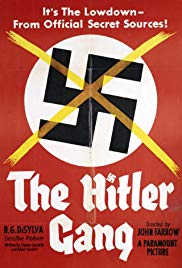
THE HITLER GANG
US, 1944, 101 minutes, Black-and-white.
Bobby Watson, Roman Bohnen, Martin Kosleck, Victor Varconi, Alex Pope, Sig Ruman.
Directed by John Farrow.
This is a little-known film by John Farrow, the Australian adventurer who arrived in Hollywood, writing novels and screenplays, eventually directing. He contributed to the war effort, especially with his Oscar-nominated Wake Island. He became an American citizen in the 1940s and was later to make the patriotic John Paul Jones.
This film is very interesting in retrospect, a portrait of Hitler from the time that he participated in World War I, was injured, became an enthusiast for Germany’s future, a demagogue, meeting up with many who were later to be part of his cabinet when he was Chancellor and during World War II.
For many, the image of Hitler was from the mid-1930s and his leadership during the war. This film is valuable in giving some intimations of his character, the development of his leadership, what was behind the capsule. He was played by Bobby Watson who portrayed Hitler in a great number of films. Interestingly, many in the cast were chosen because of their visual resemblance to the Nazi counterparts.
1. The film released in 1944, in the final year of World War II? Its portrait of Germany, postwar, the 1920s into the 1930s, the war? The portrait of Hitler, a portrait of his associates, his gang?
2. The film in some ways prophetic, the outcome of World War II? Audience response in the mid-to-late 1940s? Later audiences with the familiarity of the stories of Hitler and World War II?
3. Black-and-white photography, the atmosphere in Germany, the impact of the war, the hospitals? Germany and its social situation? Defeated? The various groups, the emergence of a nationalism, a national socialism, anti-Communist? The type of people joining the groups? The politicians using the leaders? The political developments? The people’s responses?
4. The building up of an ideology? Target victims? The Communists? The idea of blaming the Jews? Economic reasons – leading to racist ideology and persecution?
5. The portrait of Hitler, his injuries during the war, psychological blindness, his recovery, his social concern, partly awkward social manner, his power of making speeches and their impact? The gradual development of his autocratic behaviour? Those wanting to join with him, their personalities, their causes? The growing exercise of power, Hitler and his growing demands, self-confidence, being the Fuhrer?
6. Hitler and his whims, yet maintaining support, Goebbels and his sinister presence and advice, Himmler and his machinations, Goering and his support, leaving, returning? Rohm and the eventual buildup of the SSA?
7. Hitler’s sister, her arrival, bringing her niece, his initial wanting her to leave? The growing infatuation? Hitler and relationships, sexuality? The niece wanting to leave, pressure and her mother? Her death?
8. The attempt at the putsch, the beerhouse, being overcome, lack of success, the following years stalling Hitler’s progress?
9. Von Hindenburg, his age, concern about Germany, its place in the world? His advisers? The toleration of Hitler and his emerging group, their power? Making him Vice Chancellor?
10. The National Socialists, the Nazis, their salute, loyalty to Hitler? Hitler eventually becoming Chancellor? The plans to retain his power? The suggestion of the burning of the Reichstag? The visuals?
11. Hitler, becoming the leader, his control, loyalties, oratory, the growing ideology?
12. And the audience knowing that this Third Reich would like not last many years?